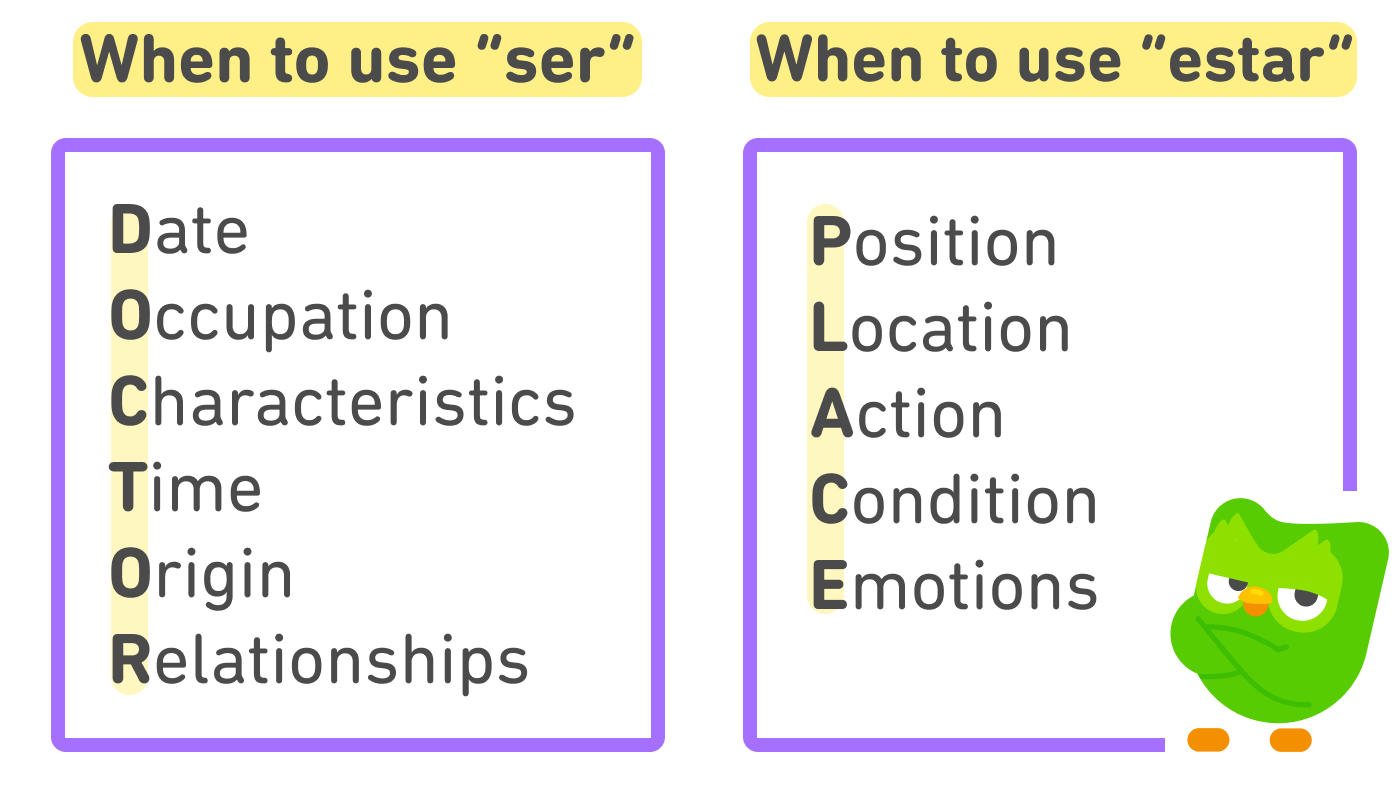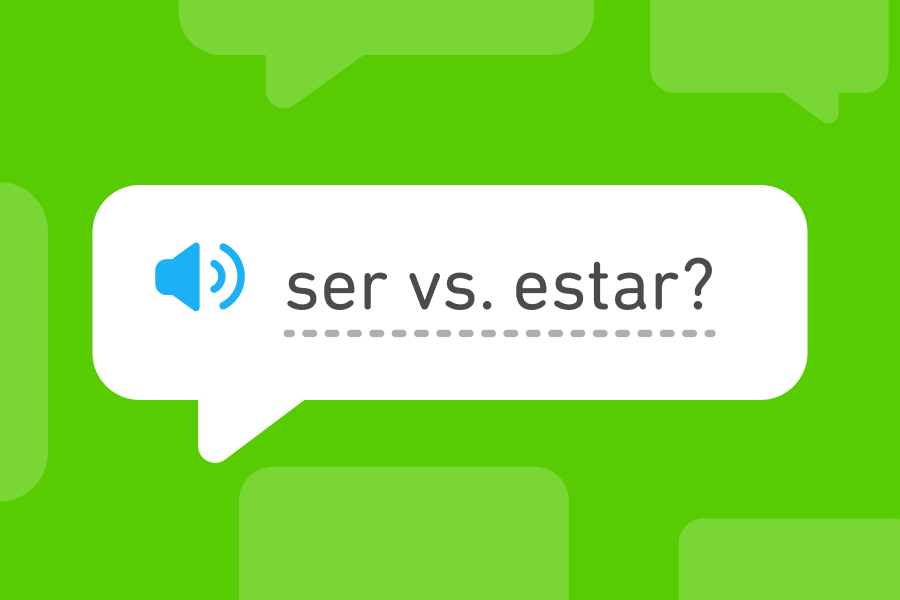If you are a new Spanish learner, you’ve probably wondered about the difference between ser and estar, two verbs that can mean “to be.” Not to worry! There are lots of tricks to learning ser and estar and when to use each.
Here’s what you need to know about how to conjugate ser and estar, the most common uses of each, and some easy ways for you to remember the difference. You’ll never have to struggle with these two again!

How to conjugate ser and when to use it
Ser is an irregular verb, which means that it doesn’t follow the regular pattern for verb endings. But you’ll see the forms of ser so often that you’ll get lots of practice with them! Like all Spanish verbs, ser will change depending on who the subject is—we do this in English, too, by saying I am but she is. Here’s how you conjugate ser:
SER (to be)
| Conjugation | Example | Translation |
|---|---|---|
| (yo) soy | Yo soy talentosa. | I am talented. |
| (tú) eres | Tú eres inteligente. | You are intelligent. |
| (él/ella/usted) es | Él es de Chicago. Ella es una estudiante. Usted es un doctor. |
He is from Chicago. She is a student. You are a doctor. |
| (nosotros/nosotras) somos | Nosotros somos buenos amigos. | We are good friends. |
| (ellos/ellas/ustedes) son | Ellos son de Francia. Ellas son mis primas. Ustedes son dentistas. |
They are from France. They are my cousins. You all are dentists. |
There’s an easy way to remember some of the most common uses of ser, and that’s by remembering the acronym DOCTOR: Each letter in DOCTOR stands for one of the situations in which you’ll use ser!
| Situation | Example | |
|---|---|---|
| D | Date Use ser when you want to give someone the date |
Hoy es el 23 de septiembre. Today is September 23. |
| O | Occupation Use ser when you want to talk about your occupation |
Yo soy una doctora. I am a doctor. Nosotras somos abogadas. We are lawyers. |
| C | Characteristics Use ser when describing physical characteristics, qualities, or personality traits |
LeBron James es famoso. LeBron is famous. Ustedes son introvertidos. You all are introverted. |
| T | Time Use ser when you want to talk about the time. Note: Remember to use es for 1:00 because it is one hour (singular) and son for all the other times because they’re more than one hour (plural)! |
Es la una de la tarde. It is 1:00pm. Son las seis y media de la mañana. It is 6:30am. |
| O | Origin Use ser when you want to talk about where someone or something is from |
Ustedes son americanos. You all are American. El auto es alemán. The car is German. |
| R | Relationships Use ser when you want to talk about your relationship with someone |
Olga es mi abuela. Olga is my grandmother. Ellos son mis tíos. They are my uncles. |
How to conjugate estar and when to use it
Just like ser, estar is also an irregular verb that you’ll get lots of practice with! Here’s how you conjugate it:
ESTAR (to be)
| Conjugation | Example | Translation |
|---|---|---|
| (yo) estoy | Yo estoy bien. | I am well. |
| (tú) estás | Tú estás en la biblioteca. | You are at the library. |
| (él/ella/usted) está | Él está enfermo. Ella está bailando. Usted está estudiando español. |
He is sick. She is dancing. You are studying Spanish. |
| (nosotros/nosotras) estamos | Nosotros estamos contentos. | We are happy (content). |
| (ellos/ellas/ustedes) están | Ellos están en Londres. Ellas están comiendo tacos. Ustedes están en la fiesta. |
They are in London. They are eating tacos. You all are at the party. |
There is also an easy way to remember some of the most common uses of estar, and that’s by remembering the acronym PLACE: Each letter stands for one of the situations in which you’ll use estar!
| Situation | Example | |
|---|---|---|
| P | Position Use estar when you want to talk about where something is placed |
¿Dónde están mis lentes? Where are my glasses? Tus lentes están en la mesa. Your glasses are on the table. |
| L | Location Use estar when you want to talk about where something or someone is |
Yo estoy en el restaurante. I am in the restaurant. Mis amigos están en la fiesta. My friends are at the party. |
| A | Action (what is happening) Use estar when you want to describe what someone is doing. Note: For Action, you’ll also need the -ing form of the second verb! |
Usted está estudiando. You are studying. Nosotros estamos comiendo pizza. We are eating pizza. |
| C | Condition Use estar when you want to talk about the state of something or someone |
¿Están enfermas? Are you all sick? Yo estoy cansada. I am tired. |
| E | Emotions Use estar when you want to talk about your feelings |
Tú estás contento. You are happy. Ella está triste hoy. She is sad today. |
Ser or estar? Let’s try a few examples!
Ready to put these tips to the test? Try these two challenges!
Keep in mind the DOCTOR uses for ser and the PLACE uses for estar. You’ll find the answer key at the end of the post.
Challenge 1
Let’s do one together:
| Choose between ser and estar | |
|---|---|
| Ella ___ mi mamá. | es or está |
💡 That one has to be es (a form of ser) because the sentence is describing a relationship.
Now it’s your turn!
| Choose between ser and estar | |
|---|---|
| 1. ¿Qué hora ___ ? | es or está |
| 2. Ustedes ___ de Mallorca. | son or están |
| 3. ¿Cómo ___ tú hoy? ¿Bien, mal, más o menos? | eres or estás |
| 4. Nosotros ___ hermanos. | somos or estamos |
| 5. Ellas ___ en el parque. | son or están |
How did you do? Too easy? Try Challenge 2 when you are ready!
Challenge 2
Let’s do one together:
| Write the form of ser or estar | |
|---|---|
| Ella ___ enojada. |
💡 That one has to be está (a form of estar) because the sentence is describing an emotion.
Now it’s your turn!
| Write the form of ser or estar | |
|---|---|
| 1. ___ la una y media de la tarde. | |
| 2. Las profesoras ___ altas. | |
| 3. El libro ___ en la oficina. | |
| 4. El Señor Gómez ___ de Bolivia. | |
| 5. Mis padres ___ estudiando español también. |
To be or… to be? That is the question!
As you can see, ser and estar are some of the most important verbs in Spanish, because they are so useful! Now you have a great way to remember when you need to use one over the other. And the more you practice, the easier it gets to express yourself! Look out for the different forms of ser and estar in your next Duolingo lessons, and see which DOCTOR or PLACE situation each sentence fits with!
And don’t forget to check your answers below! How did you do? For more answers to your ser and estar questions, write to us at dearduolingo@duolingo.com.
Check here for the answers to the challenges!
Challenge 1
| Sentence | Translation | Situation |
|---|---|---|
| 1. ¿Qué hora es? | What time is it? | This one has to be ser because we are talking about the Time. |
| 2. Ustedes son de Mallorca. | You all are from Mallorca. | This one has to be ser because we are talking about Origin. |
| 3. ¿Cómo estás tú hoy? ¿Bien, mal, más o menos? | How are you doing today? Good, bad, so-so? | This one has to be estar because we are talking about someone’s Condition. |
| 4. Nosotros somos hermanos. | We are brothers. | This one has to be ser because we are talking about a Relationship. |
| 5. Ellas están en el parque. | They are at the park. | This one has to be estar because we are talking about someone’s Location. |
Challenge 2
| Sentence | Translation | Situation |
|---|---|---|
| 1. Es la una y media de la tarde. | It’s one thirty in the afternoon. | This one has to be ser because we are talking about the Time. |
| 2. Las profesoras son altas. | The teachers are tall. | This one has to be ser because we are talking about someone’s Characteristics. |
| 3. El libro está en la oficina. | The book is in the office. | This one has to be estar because we are talking about a Location. |
| 4. El Señor Gómez es de Bolivia. | Mr. Gomez is from Bolivia. | This one has to be ser because we are talking about Origin. |
| 5. Mis padres están estudiando español también. | My parents are studying Spanish, too. | This one has to be estar because we are talking about an Action (what is happening). |
